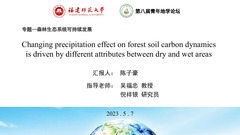Changing precipitation effect on forest soil carbon dynamics is driven by different attributes between dry and wet areas
编号:872
稿件编号:3499 访问权限:私有
更新:2023-04-08 23:36:20 浏览:892次
快闪报告
摘要
Changes in precipitation patterns have the potential to significantly affect the global carbon (C) cycle by altering soil organic carbon (SOC) dynamics. Comparing the patterns and drivers of soil C responses to precipitation changes in wet and dry forests can improve our understanding of soil carbon-water coupling. In this study, we conducted a meta-analysis to assess the effects of precipitation changes on soil dissolved organic carbon (DOC), microbial biomass carbon (MBC), SOC concentrations, and carbon dioxide (CO2) flux across a broad range of forest sites in dry and wet regions. The results showed that both the soil DOC and MBC concentrations decreased significantly (by averages of 7.8 and 7.9%, respectively) at the wet sites, but increased (by 1.2 and 10.2%, respectively) at the dry sites under increased precipitation conditions. The soil MBC concentrations decreased by 17.5% at the wet sites but by 4.1% at the dry sites under reduced precipitation conditions. The soil CO2 flux decreased by 18.9% and 14.3% at the wet and dry sites, respectively, under reduced precipitation. The responses of the soil MBC concentrations were influenced by precipitation intensity, whereas soil DOC and SOC concentration, and CO2 flux were regulated by the soil texture and climate. Clearly, soil MBC was more sensitive to increased precipitation at the dry sites than at the wet sites. Under reduced precipitation, changes in soil MBC concentration and CO2 flux were stronger at the wet sites than at the dry sites. To enhance forecasting of soil C cycles and functional alterations in a changing climate, the differing response mechanisms in dry and wet areas should be considered using process-based climate models.
关键字
Precipitation change; Forest soil; Soil organic carbon;
稿件作者
陈子豪
福建师范大学
卫芯宇
福建师范大学
倪祥银
福建师范大学
吴福忠
福建师范大学
廖姝
福建师范大学


发表评论